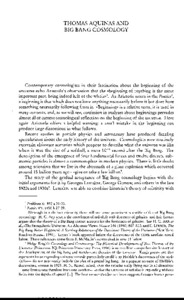Por favor, use este identificador para citar o enlazar este ítem:
https://repositorio.uca.edu.ar/handle/123456789/12848| Campo DC | Valor | Lengua/Idioma |
|---|---|---|
| dc.contributor.author | Carroll, William E. | es |
| dc.date.accessioned | 2021-11-11T15:15:39Z | - |
| dc.date.available | 2021-11-11T15:15:39Z | - |
| dc.date.issued | 1998 | - |
| dc.identifier.citation | Carroll, W. E. Thomas Aquinas and big bang cosmology [en línea]. Sapientia. 1998, 53 (203). Disponible en: https://repositorio.uca.edu.ar/handle/123456789/12848 | es |
| dc.identifier.issn | 0036-4703 | - |
| dc.identifier.uri | https://repositorio.uca.edu.ar/handle/123456789/12848 | - |
| dc.description.abstract | Abstract: Contemporary cosmologists in their fascination about the beginning of the universe echo Aristotle's observation that the «beginning of anything is the most important part, being indeed half of the whole»'. As Aristotle notes in the Poetics2, a beginning is that which does not have anything necessarily before it but does have something necessarily following from it. «Beginning» is a relative term; it is used in many contexts, and, as we will see, confusion in analyses about beginnings pervades almost all of current cosmological reflection on the beginning of the universe. Here again Aristotle offers a helpful warning: a small mistake in the beginning can produce large distortíons in what follows. Recent studies in particle physics and astronomy have produced dazzling speculations about the early history of the universe. Cosmologists now routinely entertain elaborate scenarios which propose to describe what the universe was like when it was the size of a softball, a mere 10' second after the Big Bang. The description of the emergence of four fundamental forces and twelve discrete subatomic particles is almost a common-place in modern physics. There is little doubt among scientists that we live in the aftermath of a giant explosion which occurred around 15 billion years ago —give or take a few billion3. The story of the gradual acceptance of Big Bang cosmology begins with the initial arguments for it by Georges Lemaitre, George Gamow, and others in the late 1920s and 1930s4. Lemaitre was able to combine Einstein's theory of relativity with the astronomical observations of Edwin Hubble5 to propose the theory that the entire universe is evolving in time from a «primeval atom», a superdense state of matter that somehow «exploded». Since the history of science is frequently written from the point of view of the winners, it is easy to forget how controversia) the claim was that the universe is expanding. | es |
| dc.format | application/pdf | es |
| dc.language.iso | eng | es |
| dc.publisher | Pontificia Universidad Católica Argentina. Facultad de Filosofía y Letras | es |
| dc.rights | Acceso abierto | * |
| dc.rights.uri | http://creativecommons.org/licenses/by-nc-sa/4.0/ | * |
| dc.source | Sapientia. 1998, 53 (203) | es |
| dc.subject | Tomás de Aquino, Santo, 1225?-1274 | es |
| dc.subject | COSMOLOGIA | es |
| dc.subject | ORIGEN | es |
| dc.subject | TOMISMO | es |
| dc.title | Thomas Aquinas and big bang cosmology | es |
| dc.type | Artículo | es |
| uca.disciplina | FILOSOFIA | es |
| uca.issnrd | 1 | es |
| uca.affiliation | Fil: Carroll, William E. Cornell College; Estados Unidos | es |
| uca.version | publishedVersion | es |
| item.languageiso639-1 | en | - |
| item.grantfulltext | open | - |
| item.fulltext | With Fulltext | - |
| Aparece en las colecciones: | SAP - 1998 Vol LIII nro. 203 | |
Ficheros en este ítem:
| Fichero | Descripción | Tamaño | Formato | |
|---|---|---|---|---|
| thomas-aquinas-big-bang.pdf | 515,54 kB | Adobe PDF |  Visualizar/Abrir |
Visualizaciones de página(s)
157
comprobado en 27-abr-2024
Descarga(s)
254
comprobado en 27-abr-2024
Google ScholarTM
Ver en Google Scholar
Este ítem está sujeto a una Licencia Creative Commons

